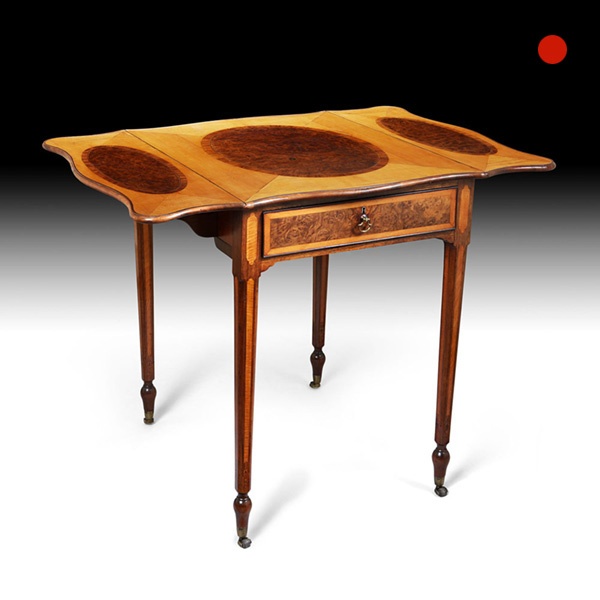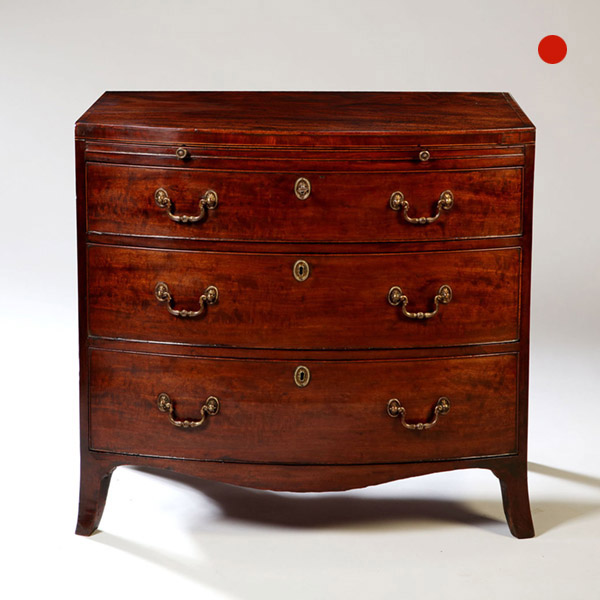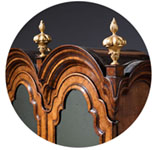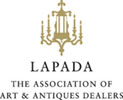A George III mahogany spider-leg table attributed to Thomas Chippendale 1768
£12,000
Follow Us
A George III mahogany spider-leg table attributed to Thomas Chippendale 1768
An Important George III mahogany spider-leg table attributed to Thomas Chippendale
1768. England
The tulip banded rectangular mahogany drop-leaf top with gateleg action, on a straight mahogany frieze with oak lined cockbeeded drawers to each short side, on eight slender columnar form turned legs and stretchers ending in pad feet.
Employing superb timber, this ‘neat’ mahogany table is a wonderful example of Chippendale’s utilitarian furniture which, through the sheer quality of materials and execution, is at once simple and distinguished. Chippendale supplied, ‘a neat Mahogany 8 leg Table of fine wood’, on 9 June 1768 at a cost of £2 2s 0d and a further pair of ‘2 neat Mahogany Spider leg Tables of good wood’, probably similar in form to those at Dumfries House from 1760 although not necessarily by Chippendale.
For a related example, see the spider-leg table sold Christie’s London, 31 October 2012, lot 79 (£13,750)
Sir Edward Knatchbull, 7th Bart. (1704-1789) comissioned Thomas Chippendale to make a ‘neat Mahogany 8 leg Table of fine wood’, on 9 June 1768 at a cost of £2 2s 0d. (request image)
Sir Edward Knatchbull’s account of furnishings with Thomas Chippendale, 9 June October 1768, ‘To a neat Mahogany 8 leg Table of fine wood £2 2s 0d’ (The Knatchbull-Brabourne MSS U951/A18/26);
Inventory, 1885, p. 66, in the ‘Chintz Room’;
Inventory, 1926, p. 27, in the ‘Service Room’;
Christopher Gilbert, The Life and Work of Thomas Chippendale, Vol. II, London, 1978, p. 224, fig. 410.
A very similar table is pictured in The Life and Work of Thomas Chippendale, Vol. II by Christopher Gilbert, page 224.
Condition
Good. Wear consistent with age and use.
Dimensions
Height: 27.96 in (71 cm)
Width: 13 in (33 cm)
Depth: 31.11 in (79 cm)
PREVIOUSLY SOLD

18th Century George III Satinwood and Pollard Oak Pembroke Occasional Table
An exceptionally fine and rare George III satinwood and pollard oak Pembroke table. The padauk top is veneered in satinwood cantered by large ovals of tightly clustered burr pollard oak reserves, bordered in princess wood and lined with fine ebony and box stringing.

George III Sheraton period bow-fronted caddy topped mahogany chest of drawers
A fine George III Sheraton period bow-fronted mahogany chest of drawers with brushing slide. The chest has the perfect time aged colour to its original wax finished surface and has truly commendable proportions. I love everything about this outstanding and original piece.

18th Century George III Satinwood and Pollard Oak Pembroke Occasional Table
An exceptionally fine and rare George III satinwood and pollard oak Pembroke table. The padauk top is veneered in satinwood cantered by large ovals of tightly clustered burr pollard oak reserves, bordered in princess wood and lined with fine ebony and box stringing.

George III Sheraton period bow-fronted caddy topped mahogany chest of drawers
A fine George III Sheraton period bow-fronted mahogany chest of drawers with brushing slide. The chest has the perfect time aged colour to its original wax finished surface and has truly commendable proportions. I love everything about this outstanding and original piece.
YOU MAY ALSO LIKE
No Results Found
The page you requested could not be found. Try refining your search, or use the navigation above to locate the post.
No Results Found
The page you requested could not be found. Try refining your search, or use the navigation above to locate the post.










